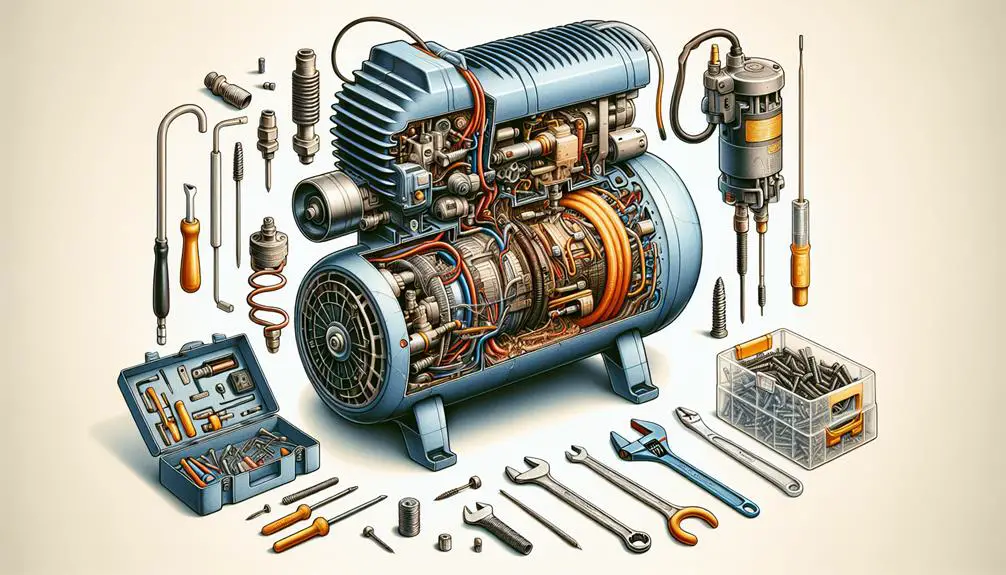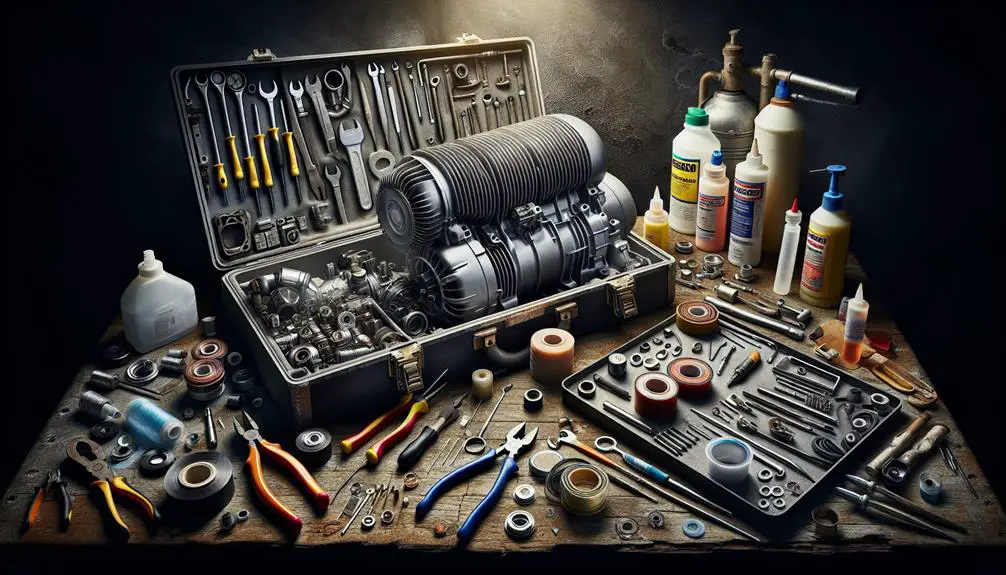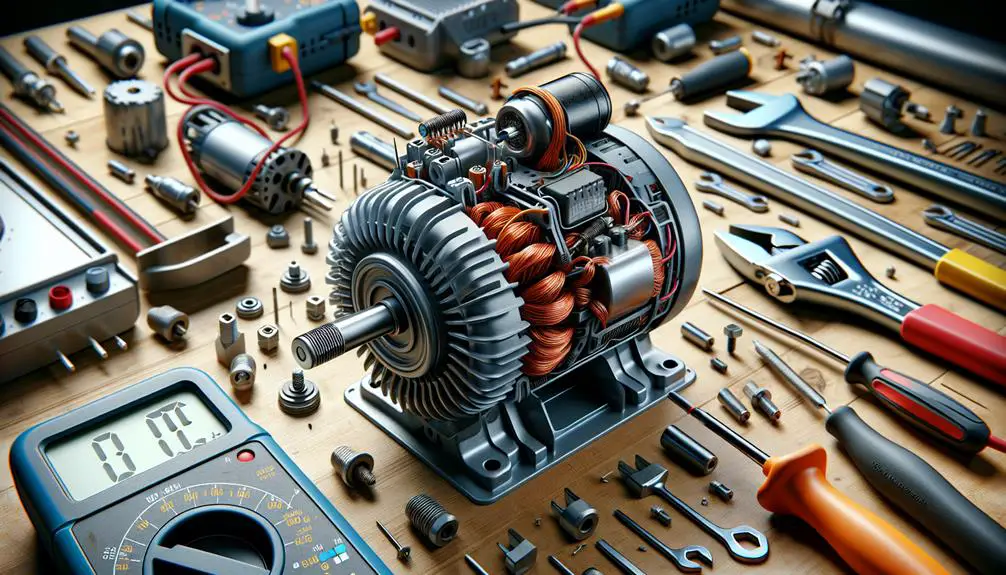Fixing a broken air compressor involves several steps such as checking and replacing air filters.
Repairing air leaks is another crucial aspect of the repair process.
Restoring faulty valves is necessary to ensure proper functioning.
Troubleshooting motor problems is also essential to address any underlying issues.
Identifying Common Issues

Before you can fix your air compressor, it's crucial to pinpoint the problem, often appearing as unusual noises, leaks, or pressure issues.
To start, if you're hearing strange sounds, it could be a sign of internal wear or a loose component. Knocking or rattling often indicates something's amiss inside, requiring a closer inspection. You'll need to open up your compressor to check for any loose screws or damaged parts that might be causing the noise.
Leaks are another common issue. They can greatly reduce your compressor's efficiency. Check all connections and fittings for tightness. Sometimes, applying soapy water to suspect areas can help you spot escaping air bubbles, indicating a leak. Remember, even a small leak can lead to big problems over time.
Pressure problems, whether too high or too low, can also plague air compressors. If your compressor struggles to reach or maintain the desired pressure, inspect the pressure valves and gauges. It's possible they're faulty or incorrectly calibrated. Adjusting or replacing these components can often restore proper function.
Addressing these common issues can extend the life of your air compressor and make sure it operates at peak efficiency.
Checking and Replacing Air Filters
After addressing common issues like leaks and pressure problems, it's essential to check and replace your air compressor's filters to guarantee peak performance. Dirty or clogged filters can severely impact the efficiency of your air compressor, leading to increased energy consumption and potentially causing damage to other components.
Initially, locate the air filter. It's typically found in a housing on the side of the compressor. Unscrew or unclip the housing to access the filter. Examine it closely—if it's caked with dirt or shows signs of wear, it's time for a replacement. Don't attempt to clean disposable filters as this can compromise their integrity and efficiency.
When selecting a new filter, make sure it matches your compressor's specifications. Using the wrong type can restrict airflow or fail to filter out contaminants effectively. Moreover, once you've got the right filter, install it carefully, ensuring it fits snugly in the housing. Reattach the housing, making sure it's secure but not overtightened.
Regularly checking and replacing your air filters is a simple yet vital maintenance step. It not only extends the life of your air compressor but also maintains its performance and efficiency. Keep a spare filter on hand to make this routine task even easier.
Repairing Air Leaks

Identifying and fixing air leaks is a critical step in maintaining your air compressor's efficiency and performance. Air leaks can lead to increased energy consumption and reduced pressure, compromising the functionality of your air compressor. Here's a step-by-step guide to help you tackle air leaks effectively.
Initially, you'll want to detect the leaks. You can do this by applying soapy water to suspected areas while the compressor is running. Bubbles will form where there are leaks. Once you've identified the leaky spots, it's time to get them fixed.
| Step | Action |
|---|---|
| 1. Detect | Apply soapy water to connections and hoses. Look for bubbles. |
| 2. Tighten | Use a wrench to tighten loose fittings and connections. |
| 3. Replace | If tightening doesn't fix the leak, consider replacing the faulty parts. |
Restoring Faulty Valves
Repairing faulty valves is important for making sure your air compressor operates at peak efficiency. Over time, valves can wear out or become damaged, leading to performance issues. Luckily, with a bit of know-how, you can get them back in shape.
Initially, you'll need to identify the problematic valve. Symptoms of a faulty valve include unusual noises, decreased air pressure, or your compressor struggling to start. Once identified, turn off and unplug your compressor to guarantee safety.
Here's a simple guide to help you visualize the process:
- Disassemble the valve assembly: Carefully remove the valve from the compressor. Keep track of all the small parts.
- Clean the valve: Often, dirt or debris is the culprit. Use a soft brush and a solvent suitable for your compressor to clean off any gunk.
- Inspect and replace: Look for signs of wear or damage. If the valve or its components are beyond repair, replace them with new ones.
Reassembling is just the reverse of disassembly. Make sure everything is snug and secure. Afterward, test your compressor. You should notice an improvement in its performance. Remember, regular maintenance can prevent many valve issues from developing in the beginning.
Troubleshooting Motor Problems

Having tackled valve repairs, let's now address motor issues that might be affecting your air compressor's performance. If your compressor's motor isn't running as it should, there are a few steps you can take to pinpoint and fix the problem.
To start with, check if the motor is receiving power. Make sure it's plugged in and the outlet is functioning. If it's connected to a power strip, make certain that hasn't tripped. Sometimes, it's as simple as a blown fuse or a tripped circuit breaker.
Next, listen for any unusual noises when you try to start the motor. Grinding or screeching can indicate internal mechanical problems, such as worn bearings or a misaligned shaft.
If the motor hums but doesn't start, the issue might be with the start capacitor. This component gives the motor the initial jolt it needs to start turning. Over time, capacitors can degrade and lose their capacity to hold a charge, necessitating replacement.
To conclude, overheating can cause motor failure. Make sure there's adequate ventilation around the motor and check for any dust or debris buildup that might be blocking airflow. Regular cleaning can prevent overheating and extend the life of your motor.
Conclusion
At last, you've got the tools to tackle those bothersome air compressor issues head-on. Whether it's swapping out clogged filters, sealing up leaks, fixing up those valves, or getting to the bottom of motor troubles, you're well-prepared.
Remember, most problems have straightforward fixes, so don't let them intimidate you. With a bit of patience and some elbow grease, you'll have your air compressor running like new.
Here's to smooth operations and flawless repairs!
